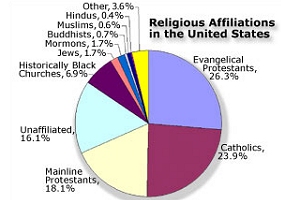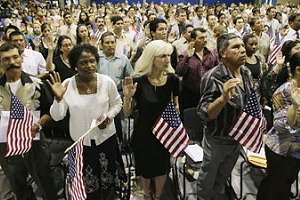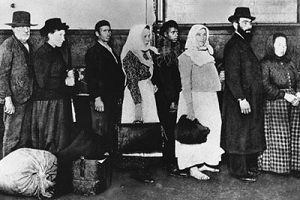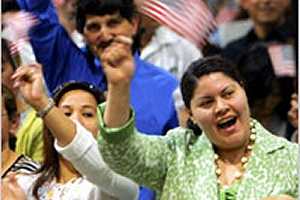America in context
U.S. Religious Landscape Is Marked by Diversity and Change

Religious affiliation among U.S. residents best can be described as "diverse and extremely fluid," according to a new poll conducted by the Pew Forum on Religion and Public Life.
The U.S. Religious Landscape Survey queried more than 35,500 adults age 18 and older living in the United States. It was conducted by telephone in 2007 in both English and Spanish.
The goal was to examine the religious makeup of American society -- not only the size of various religious groups, including the smallest ones, but also demographic characteristics, social and political values, religious practices and shifting religious affiliations.
Luis Lugo, director of the Pew Forum, added that the survey -- published in February 2008 -- will contribute to “a better understanding of the very important role religion plays in the private, personal and also the public lives of most Americans.”
More than three-fourths of those surveyed classify themselves as Christian, 5 percent belong to other faiths, and 16 percent are not affiliated with a specific religion.
Members of evangelical Protestant churches constitute the largest religious tradition in the United States (26 percent of the population), followed by Catholics (24 percent) and mainline Protestants (18 percent).
Movement Among Religions
With more than 28 percent of American adults leaving the faith of their childhoods to practice another religion -- or no religion -- the survey confirmed that “a remarkable amount of movement” is occurring.
Such movement is evident in the Protestant community. Fifty-one percent of U.S. adults surveyed identify themselves as Protestant -- a significant decline from 65 percent two decades ago. As a result, the Pew Forum concludes that Protestants are on the verge of becoming a minority among religious groups in the United States.
Catholicism has held steady over the past two decades, but that statistic obscures dramatic shifts as well. According to the survey, “Catholicism has lost more people to other religions or to no religion at all than any other single religious group.” However, such losses were offset by the number of Catholics who immigrated to the United States. The remaining Christian groups (3 percent of the population) include Mormons, Jehovah’s Witness, Orthodox (evenly divided between Greek and Russian Orthodox), and others.
Impact of Immigrants
Immigration is “contributing in a major way to the changes in the American religious landscape,” notes the Landscape Survey. Some 61 percent of immigrants are from Latin America and the Caribbean, with half of these from Mexico alone. Nearly three-fourths of Mexican immigrants and half of other Latin American immigrants are Catholic. This helps explain why one-fourth of U.S. Catholics are foreign born.
New arrivals are bringing other religious traditions to America as well. Muslims, of whom two-thirds are immigrants, account for roughly 0.6 percent of the U.S. adult population, according to the survey. Hindus are 0.4 percent of the population, with 86 percent born elsewhere. (By contrast, three fourths of Buddhists are native-born; many are converts from other faiths. They constitute 0.7 percent of the population.) The survey found that Hindus, Muslims and members of Christian Orthodox churches are the groups most heavily comprised of immigrants.
Diversity Within Religious Groups
There also is considerable diversity within religious traditions. Among Protestants, about half are evangelicals, one-third belong to mainline churches (Methodist, Lutheran, etc.) and 13 percent attend historically black churches.
In the survey, 1.7 percent identify themselves as Jewish, with Reform Judaism leading the way followed by Conservative and Orthodox Judaism.
Among U.S. Muslims, Sunnis make up half of the total, while the rest are Shiites and those who do not specify a denomination.
Buddhists, too, emerge with a number of distinct categories: Zen Buddhism, Theravada and Tibetan, among others.
Other factors like age, race and geography also influence the religious landscape. For example, mainline Protestants and Jews generally are older, while people not affiliated with a particular religion are younger. Immigrants more often are Catholic, while native-born Americans are more likely to be Protestant.
Blacks are the group most likely to report a religious affiliation. More than three-fourths are Protestant.
Protestants have a slight edge (53 percent) among non-Hispanic whites, but Catholics predominate among Hispanics (58 percent). Asians are more divided, with 27 percent Protestant, 17 percent Catholic and 53 percent other religions or unaffiliated.
Looking at geography, the Southern United States has the highest percentage of Protestants, particularly evangelicals, while the Northeast has the highest percentage of Jews, Catholics, Hindus and Muslims. The West has the most Buddhists.
No Religious Affiliation
One of the most interesting findings in the Landscape Survey is the growing number of American adults (16 percent) who do not belong to any particular religious group. Through the 1980s, this group accounted for only 5 to 8 percent of the population.
The unaffiliated group is “quite diverse” and “it is simply not accurate to describe this entire group as nonreligious,” the survey states. About one-fourth identify themselves as atheist or agnostic (4 percent of the total adult population). The rest describe their religion as “nothing in particular” (12 percent of the adult population). While half of these respondents say religion is “not important” in their lives, the others say it is “somewhat” or “very important,” even though they do not chose to be affiliated with a religious group.
The complete U.S. Religious Landscape Survey (PDF 1.13 MB) is available on the Pew Forum Web site.
By Melody Merin
Special Correspondent
Recently on America in context
American Identity: Ideas, Not Ethnicity
 Since the United States was founded in the 18th century, Americans have defined themselves not by their racial, religious, and ethnic identity but by their common values and belief in individual freedom.
Since the United States was founded in the 18th century, Americans have defined themselves not by their racial, religious, and ethnic identity but by their common values and belief in individual freedom.
Immigration and U.S. History
 Millions of women and men from around the world have decided to immigrate to the United States. That fact constitutes one of the central elements in the country's overall development, involving a process fundamental to its pre-national origins, its emergence as a new and independent nation, and its subsequent rise from being an Atlantic outpost to a world power, particularly in terms of its economic growth. Immigration has made the United States of America.
Millions of women and men from around the world have decided to immigrate to the United States. That fact constitutes one of the central elements in the country's overall development, involving a process fundamental to its pre-national origins, its emergence as a new and independent nation, and its subsequent rise from being an Atlantic outpost to a world power, particularly in terms of its economic growth. Immigration has made the United States of America.
American Dream Still Alive and Well for Immigrants
 "The great story of America is that it still offers a job to first-generation immigrants and better jobs to their children" said Ron Haskins, the author of Economic Mobility of Immigrants in the United States.
"The great story of America is that it still offers a job to first-generation immigrants and better jobs to their children" said Ron Haskins, the author of Economic Mobility of Immigrants in the United States.